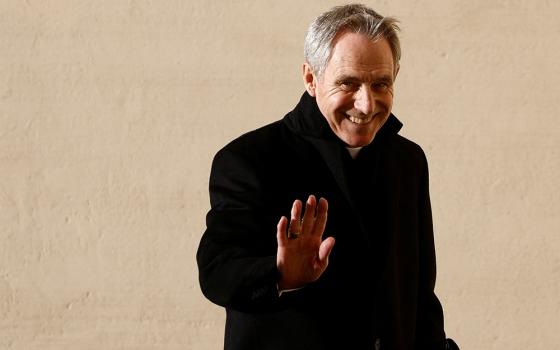Artist Ron DiCianni spent two years painting the largest mural ever of the resurrection, some 12 feet high and 30 feet wide, soon to be housed at the Museum of Biblical Arts in Dallas.
In a video about this work, he says, “The resurrection of Jesus Christ is the single act in history that separates Christianity from every other religion, every other philosophy, and every belief system. God gave me this incredible idea of having Christ emerge from the tomb which I've never seen done before. I wanted to stop a moment in time, when Jesus grabbed the sides of the tomb and walked out.”
As much as I admire DiCianni’s artistic skills and honor his perspective, I don’t agree with it. Like many, he takes a very literal approach to the resurrection, focusing on the biblical accounts as historically accurate. Even top-notch biblical scholars cannot fully unravel the mystery of what happened after Jesus’ death based on the resurrection narratives — what might have been fact, myth, or projection by the early Christian community. After all, no one caught it on camera.
It’s freeing that we don’t have to spend our precious energy trying to figure it out. Faith is a lot more than an intellectual belief in a doctrine, which does little to give us the inspiration we so sorely seek. What we want is to have “our hearts burning within us,” experiencing the same thrill as the Emmaus disciples who knew that Jesus still walked beside them, not in an occasional physical way, but a constant spiritual one.
The question we might profitably ponder this Easter is: What profound reality is God trying to communicate through the resurrection and how can that have significance and power for us today? God knows our world is a mess, so surely a reality this central to Christianity has something vital to say, some great grace to impart. It's not just something that happened once and for all in the past.
As I look around me, I see a lot of fear and hopelessness, which is quite understandable if we just look at the material side of things, which is what Jesus’ disciples did after his death. Things appeared totally dismal to them. But God awakened in them an intense realization that Jesus’ courageous death resulted in new life for him, them, and the world.
To help them and us to “get it,” the resurrection is portrayed in the Bible as an event bigger than life. There’s power, glory, dazzling angels, the earth quaking, stones miraculously moved —a n explosive, brilliant event, big enough to convince us that God’s saving love permeates the universe and is always with us even in the face of loss and change.
This Easter, God is once again calling us to trust that death is a precondition for rebirth, disintegration undergirds reintegration, and dying seeds sprout new life, not only in our personal lives, but on a cosmic level.
One of the reasons I stay hopeful in the face of so much bad news is that I know something of evolutionary history, and how God and the universe have always fashioned something wonderful and unexpected out of the demise of the old. With this inspiration and the witness of Jesus who went willingly to his death, maybe we too can embrace the death of much of what we hold dear, confident that something better will replace it.
Our problem is that we’ve only put stock in the physical aspect of things, and failed to see the numinous, divine light that infuses it, and goes beyond it. We’re stuck, scared and quivering, in a confining tomb, when God has rolled back the stone of unconsciousness and invited us to emerge into the light. We are more than matter. We are cosmological, spiritual beings yearning to experience God and the infinity of which we are a part.
Quantum Theology author Diarmuid O’Murchu expresses it this way, “The concept of resurrection helps us to contextualize our affinity to mystery, to make real and tangible the awe and apprehension that is deep within our being. It embodies our yearning for infinity, stretching back over billions of years and serving to connect us with the infinite eons that still lie ahead.”
This is something of how I felt when I read Embraced by the Light many years ago. As the author described her near-death experience with its glimpse of unbounded existence and awareness, my heart thrilled as it went on the journey with her in imagination. I knew in my soul that I was part and parcel of this divine matrix which filled the universe.
It helped me to see that there is no duality, no opposition between earthly existence and the spiritual realm. The resurrection does not imply that we should merely endure life in this world because all that matters is life after death, an error that has resulted in many sad consequences throughout history. God is one and our world is one in all its dimensions. The resurrection proclaims that the Cosmic Christ is with us fully, permeating every atom of matter, working redemption in all things, even in the groaning of creation. There is a seamless continuity and unity between matter and spirit, death and life, this world and the next.
So let us not be disbelieving, but believing, living out of the powerful, loving, creative force of Jesus’ enduring presence, allowing Him to transform us into heroic disciples, so desperately needed in today’s world, then our minds and hearts are free to soar with new insights to transform our lives.
Jesus’ enemies thought they could be rid of him by killing him, but they were wrong. They didn’t count on the fact that, bound no longer by physical limitations, his spirit would be unlimited in its influence. The resurrection proclaims to those who destroy, “You can kill the body, but you can’t kill the soul. There’s another whole spiritual realm to be reckoned with over which you have no power.”
On the surface, evil often seems to win out, but it never does ultimately. There is more than meets the eye. Good always has its reward and prevails. The lesson might be to be bold in doing what is right and standing up for justice and God’s values no matter the cost because you will be vindicated in the end. The story doesn’t end with death. Death is just a transition into another realm, not the end of you.
I see the tomb and stone in front of it as symbolic. Often we live in a cramped, limited space of our own making. It’s very time and earth-bound, and ego-based with minimal consciousness. But once we let God roll the stone away, we emerge glorious as Jesus did, our eyes opened to the infinite possibilities in front of us.
In death, we let go of our bodies, and are released into a potential relationship with the whole of universal life. Easter is symbolic of victory after suffering for what is right. Evil doesn’t prevail. You can kill the body, but not the soul.



